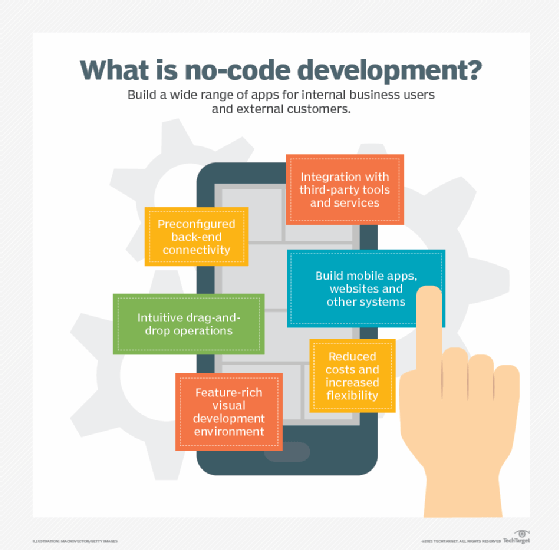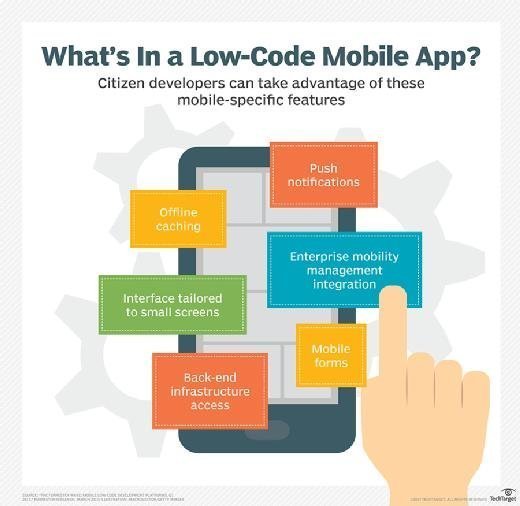New Suggestions To Picking Low-Code Platform Examples
New Suggestions To Picking Low-Code Platform Examples
Blog Article
Speed-Wise Low-Code Applications Have Many Advantages.
Low-code application development significantly enhances the speed of development due to a variety of crucial factors. Development Environment:
Drag-and-Drop Interfaces: Low-code platforms provide visual tools for designing applications. Drag-anddrop components enable developers to rapidly assemble applications, without needing to write code.
A lot of low-code platforms come with prebuilt templates and components. This allows developers to quickly prototype or build applications, without needing to start from scratch.
Reduced Coding Requirements
Automated Coding Generation Low-code platforms generate the code automatically using the visual model created by the developers. This helps reduce the need to code manually and accelerates the development process.
Reusable component: Developers can use the same components for various projects. This cuts down time spent on testing and writing code.
A more efficient collaboration
Low-code platform tools typically include versions control, testing deployment. This facilitates seamless collaboration between teams.
Citizen Development: Users of businesses and non-developers are able to contribute to application development using intuitive interfaces, thus reducing bottlenecks that is often caused by the limited accessibility of professionals.
Rapid Iteration & Prototyping
Rapid Prototyping Developers can swiftly develop prototypes to allow ideas to be evaluated and feedback to be gathered and analyzed, which leads to faster iterations.
Simple modifications. The visual nature that low-code development provides makes it easy to modify and update applications. This accelerates the process of enhancing and improving applications in response to user feedback.
Pre-built Integrations:
API Integrations: Platforms that are low-code usually have pre-built connectors for well-known APIs and services, reducing the time required to connect external systems.
Data Integration: Built-in tools to integrate data simplify the connection to databases and other data sources. This helps speed up development.
Deployment, scaling and deployment
One-Click-Deployment: Many Low-Code platforms provide one-click option for deployment. This cuts down on the time and effort needed to deploy an application.
Cloud-Based Solutions: Cloud-based, low-code platforms can handle scaling and infrastructure management which allows developers to concentrate on the logic of their applications and functions instead of the logistics of deployment.
The main advantage of low code application development in terms of speed, is its ability to automatize and simplify many aspects of the process. This allows quicker delivery of applications and quicker adaptations to changing requirements. See the top rated Low-code Platform for application development hints for more advice including app platforms, microsoft azure sql, low code platforms, multiplatform mobile app development, azure sql server, multiplatform mobile app development, rad application development, ms azure sql, application modernization, push alerts and more.
Low-Code Applications Are Cost-Effective.
Low-code application development has numerous advantages when it comes to cost-efficiency, making it an attractive option for businesses looking to reduce their development costs while still delivering top-quality software. Here are a few of the key advantages.
Reduced Coding: Low-code systems cut down on the amount of hand-coding that is required which helps developers save time and energy in the process of creating applications. This results in less labor costs.
Reduced Developer Resources: Because low-code is faster and simpler to develop, less specialized developers will be required. This reduces the need for hiring and personnel costs.
Speedier Time to Market
Development speed up Visual tools for development and pre-built parts provided by platforms with low-code support rapid design of applications, which allows companies to get their products on the market quicker. This could lead to quicker revenue generation and better competitive positioning.
Rapid prototyping. Businesses can quickly test and develop prototypes. This reduces time spent during the development phase, and enables quicker iterations based on feedback from users.
Reduced Maintenance Costs
Because of their modular architecture and standardised components, low-code platforms typically make it easier to maintain applications. Maintenance and support costs are cut.
Automated updates: Many low-code platforms automatically manage patches and updates, ensuring that applications are secure and up-to-date with no need for a lengthy manual intervention.
Efficient Resource Utilization:
Contributions from non-developers Low-code platforms permit both developers and business users to participate in the process of development. This makes it possible for businesses to take advantage of the skillsets of a wide range of employees.
Improved Utilization of IT Resources: IT departments can focus on more strategic initiatives instead of being slammed with mundane development tasks increasing overall efficiency and productivity.
Models of pricing that are scalable:
Subscription-Based Price: Many low code platforms offer an affordable subscription-based pricing model that grows according to the amount of usage. This allows business to be able to align their spending with the actual demands and growth while avoiding large up-front costs.
Pay-Asss-You-Go Option: Some platforms offer pay-as-you-go options that guarantee businesses only pay when they make use of resources. This is particularly useful for smaller and startup businesses with a limited budget.
Reduced Third-Party Costs for Software:
Built-in Functionalities : A low-code software usually comes with built-in functionality and integrations that reduce the requirement for third-party tools, software and licenses.
Pre-Built Integrations: Availability of pre-built integrations that integrate with the most popular platforms and services eliminates the requirement for custom development, which saves both time and money.
Improved ROI
Increased Return On Investment The combination of speedy development and lower expenses with a faster time to marketing allows businesses to get a greater return on investment.
Increased Agility: Businesses are able to rapidly adapt to market trends and the needs of customers, ensuring that they stay relevant and are able to capitalize on new opportunities as they arise.
Train for More for
User-Friendly Interfaces: The intuitive interfaces and user-friendly features offered by low-code platforms reduce the learning curve thereby making it less necessary to conduct lengthy training.
Accessible Resources: A lot of platforms using low-code provide extensive instructional materials, tutorials, as well as community support. This reduces the necessity for formal education, as well as the costs associated with it.
Streamlined Collaboration:
Improved Collaboration Tools : The collaboration tools that are built into the software aid in communication and coordination among team members. This leads to an efficient development and lower overhead.
Unified Development Environment. An unified development platform helps reduce costs and streamline workflows by making it easier to manage multiple tools.
The cost-effectiveness in low-code app development comes from its ability lower maintenance and development costs, speed up the time to market, maximize resources, and also offer flexible pricing models. Low-code can provide significant financial benefits to businesses. Have a look at the most popular Enterprise application development with Low-code Platform hints for website tips including application development platforms, microsoft azure sql, rapid application design, cloud software applications, develop web app, rad application development, cross platform app development, database in azure, develop mobile application, build a docker container and more.
The Advantages Of Low-Code Development For Application Development In Terms Of Restrictions And The Possibility Of Customization
Low-code app development is a well-balanced solution that offers significant benefits in terms of overcoming limitations while also permitting customization. These are the major advantages: Managing limitations
: .
Simplified development: Low code platforms make it easier to develop by providing templates and pre-built elements. This helps speed up applications to be deployed, even more complex ones.
Guided Workflows: Many platforms have guided workflows as well as wizards to help developers navigate through complex processes, reducing the likelihood of errors and making sure that the process is consistent.
Scalability Solutions
Scalability built-in Lowcode platforms typically include features to allow for the scalable architecture. They allow applications to handle growing loads without requiring major overhauls.
Performance Monitoring: Integrated performance monitoring tools and optimization ensure the applications run as efficiently as possible, regardless of their size.
Security and Compliance
Integrated Security Features : Low codes platforms have security features built-in like encryption and access control based on role. They also run automated checks of compliance to address security concerns.
Platforms regularly update their security and compliance measures to ensure that their applications are protected against new threats.
Capabilities for Customization:
Extensibility:
Custom Code Integration: Low-code platforms often permit the integration of custom code (e.g., JavaScript, Python), enabling developers to expand the capabilities beyond the standard offerings.
Custom Modules and Plugins: Developers have the option to create customized modules or plugins in order to tailor specific functions to meet the specific requirements of a particular business.
APIs Integration:
API Support: Comprehensive API support permits seamless integration of external systems and services. This enables large customization and connection.
Third-Party Services : Low-code platforms typically provides pre-built connections to well-known services offered by third parties which makes integration and customization easier.
Flexible UI/UX Design:
Customizable user interfaces for developers: Developers are able to modify and design the user interfaces in order to fulfill specific branding requirements as well as usability needs, providing the user with a customized experience.
Responsive Design: Built-in responsive design capabilities make sure that applications can be customized for various sizes of screens and devices.
Business Logic Customization
Visual Workflow Designers: These graphic tools can be used to customize and design workflows as well as business logic, which allows developers to develop complex, custom-designed processes.
Conditional Logic and Scripting: Platforms permit the use of conditional logic and custom scripting to handle specific business rules and situations.
Data Management
Custom Data Models Developers can choose to create customized data models specifically for particular applications, adjusting data handling to specific business requirements.
Advanced Data Processing: Integration with advanced data processing tools and capabilities allows for customizing the way data is processed and used within the application.
Balance Customization and Limitations
Frameworks and Standards
Low-code platforms encourage the use of industry-standards and best practices. This results in top-quality software that is scalable and safe.
Governance Frameworks. Inbuilt frameworks for governance make sure that any modifications do not compromise the security, compliance or the integrity of the application.
Iterative development and feedback:
Rapid Prototyping : Developers can quickly test their customizations and prototypes based on the feedback of users, improving the application in line with their preferences.
Continuous Improvement: Low-code systems support continuous improvement, which allows for constant customization and enhancements when business requirements change.
User Empowerment
Empowering Citizen-Developers: Low-code platforms boost the number of contributors capable of enhancing and customizing applications, by giving them the ability to modify their applications through simple user interfaces.
Support and training: A lot of platforms include extensive training resources and support services that assist users in creating customizations which are efficient without affecting the performance or stability.
Overall, Low-code application creation gives you a framework that's sturdy and adaptable enough to meet restrictions while allowing the possibility of extensive customisation. This balance lets businesses develop and maintain functional applications tailored to their needs while maintaining high standards for quality, security, and the ability to scale.